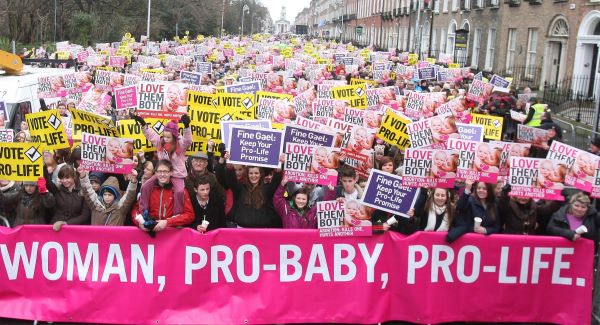The View
On June 30, the Department of Health published the first annual report on abortion following the repeal of the Eighth Amendment in 2018.
The report, though scant in detail, gave us a glimpse of the new reality of abortion in Ireland: 6,666 abortions in just one year.
During the referendum campaign, pro-life spokespeople said that the numbers of abortions would go up. We were told that we were lying and exaggerating and fear-mongering. We were told that abortion would be safe, legal and rare. But we were right, and they were wrong. Going on the official published figures, that number of 6,666 (plus 375 abortions that were performed on Irish women in Britain) compares to the 2018 figures of 2,879 abortions in Britain, plus 32 in this country: an increase of 142%.
But are the ‘winners’ of the referendum happy? It seems not. Now they’re calling for more.
Abnormality
Back in 2016, I took part in a radio interview with Colm O’Gorman and Pat Kenny. During that programme, Mr O’Gorman stated: “Nobody in this country is advocating for a specific right for women and girls to access abortion in cases of disability. Disability and fatal foetal or severe abnormality are two entirely different things.”
On June 30, the day the report was issued, the same Mr O’Gorman issued a statement on behalf of Amnesty International, a former human rights organisation, noting the 6,666 abortions in this country as “an important step forward” but cautioning that “some serious gaps remain in the legislation that are likely still forcing pregnant people to travel”.
For Mr O’Gorman, the threshold of “serious harm” to a pregnant “person’s” health is too high a bar: he seems to imply that a mother’s non-serious health issues should be sufficient to abort a baby up to viability.
He also decried the lack of access to abortion for “non-fatal impairment diagnoses”. In other words, babies who don’t tick the physical (and presumably mental) ‘perfection’ boxes. Eighty one Irish babies with disabilities were aborted in Britain in 2019. How can organisations like Amnesty talk about ‘individuals at risk’ and the importance of protecting the rights of those with disabilities, and at the same time call for legislation authorising the summary execution of at-risk children in the womb with disabilities?
We don’t know whether those children – 32 of them – were killed by poisoning or died during or after the birth”
Niall Behan of the Irish Family Planning Association also responded to the report, with its body count of 6,666. Mr Behan said “the new Government must prioritise reforms to contraception access and sexuality education and ensure that the 2021 review of the abortion law focuses on enhancing access to abortion care so that no one is left behind”. Sure enough, there is no trace left of the 6,666 souls whose lives were cut short.
But the question that has to be asked is: why Mr Behan is calling for more contraception and sex education? Given that Mr Behan and Mr O’Gorman welcomed this report, and they think that abortion is a good thing and a freedom for women, why would they want to reduce the numbers (which is what they say will happen if there is more contraception freely available)?
Either they really think abortion is a bad thing that is damaging to women and we should work to reduce it, or else, they understand that making contraception even more freely available and forcing compulsory sex education on every child will lead to even more indiscriminate sexual activity, which in turn will lead to more abortion.
Statistics
To turn to the statistics, it should be noted that 375 women had abortions in Britain last year. How do we know? Because unlike our Government, the British government publishes comprehensive statistics in their report.
From that report, we can tell that the majority of Irish women who had an abortion in Britain were single (64%); and that 44% were in their 30s (the very decade that is really a woman’s last chance at having an uncomplicated pregnancy and birth). This alone is worth examination based on a recent OECD report which found that Ireland’s actual fertility rate lags way behind its desired fertility rate. Whereas Irish women between the ages of 25 and 39 on average desire 2.74 children, the actual number of children they have is 1.66.
We also know that for 17% of Irish women, it was a repeat abortion, and that one fifth of abortions were after the 20 week mark – the half way point in pregnancy. In contrast with the figures from here, where 98% of abortions took place before 12 weeks, 73.9% of abortions on Irish women in Britain took place after 12 weeks’ gestation.
The vast majority of abortions on Irish women in Britain were surgical (82%). Just under 9% were medical abortions carried out after 20 weeks – which presumably means that the baby was too big to dismember, and that the mother was induced and had to give birth to the child.
We don’t know whether those children – 32 of them – were killed by poisoning or died during or after the birth. There were also two cases involving complications listed, which is explained as including haemorrhage, uterine perforation and/or sepsis.
Although it makes for gruesome reading, the British report does give us a picture of the reality of abortion. By contrast, former Minister for Health, Simon Harris, seemed anxious to sweep all realities under the carpet – including those relating to women’s health – by refusing to publish a comprehensive report: we don’t know how many complications arose for women as a result of an abortion carried out in this country, for instance.
If Messrs Behan, O’Gorman and Harris – repeal’s poster boys – get their way, we will have more freely available taxpayer-funded contraception, sex education forced on children without regard to their or their parents’ wishes and more and more abortion.


 Maria Steen
Maria Steen
